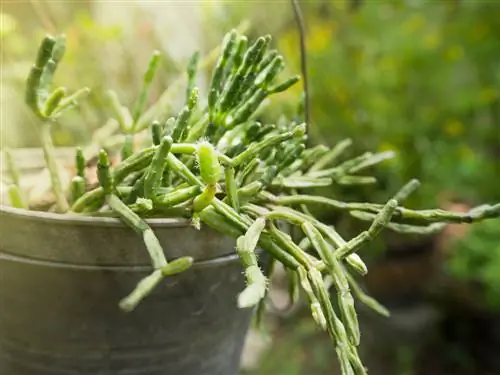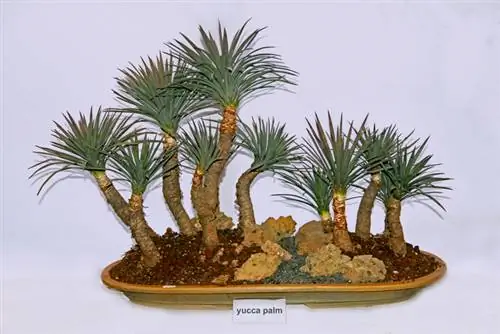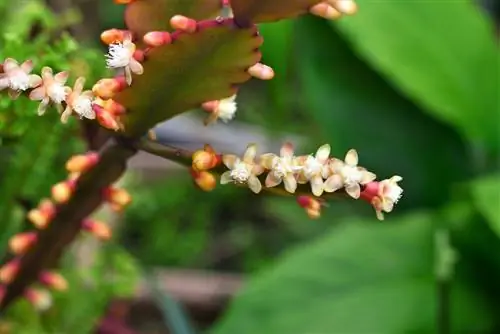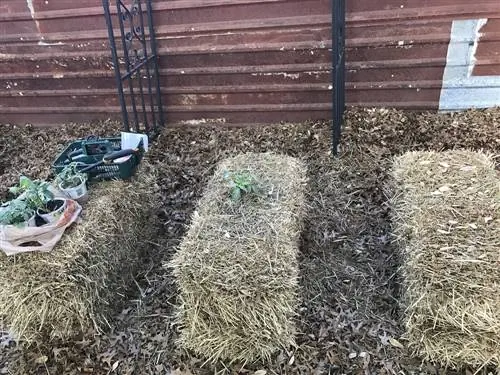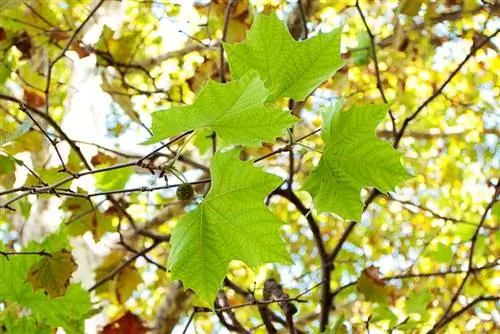- Author admin [email protected].
- Public 2023-12-25 17:45.
- Last modified 2025-01-23 11:21.
They don't look like cacti, but they actually belong to the cactus family (Cactaceae): Rhipsalis. The approximately 40 species in the genus are all characterized by long, thin and often branched shoots. This is where their generic name comes from, because the ancient Greek word “rhips” translates to “willow rod”. With the right care, you can enjoy the interesting, often wonderfully flowering plants for a very long time.
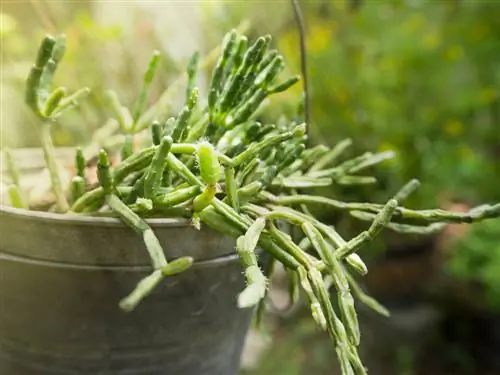
What are the special features of Rhipsalis cacti?
Rhipsalis are tropical cactus plants that are characterized by thin, long and branched shoots. They prefer bright, indirect lighting conditions and lime-free, permeable substrate. Rhipsalis cacti are easy to care for, non-toxic and ideal for hanging baskets or elevated locations.
Origin and distribution
Rhipsalis cacti are widespread in tropical Central and South America and the Caribbean. The genus also has a very special species: Rhipsalis baccifera is the only cactus species that is naturally native outside the two American continents. The species is native to tropical Madagascar and Sri Lanka as well as to some islands in the middle of the Indian Ocean. The various species grow primarily epiphytically, i.e. H. as epiphytes on the tall trees of the rainforests.
Usage
In our country, rhipsalis cacti can only be cultivated as houseplants, as the plants that come from the tropics are not hardy and need a lot of warmth. However, you can cultivate them outside over the summer months, for example on the balcony or terrace, but you have to bring them back into the house in good time - outdoor cultivation is usually over by the beginning of September at the latest.
Depending on the type and growth habit, rhipsalis are wonderfully suitable for hanging baskets that you can simply hang under the ceiling. Many varieties develop metre-long canes and often become very bushy, creating an interesting sight. Alternatively, place the plant pot on an elevated spot, such as a bookshelf or similar, so that the plant can let its long shoots grow downwards. Other species, however, develop rather short but very dense shoots and develop an almost shrub-like appearance. These are best cultivated in a normal flower pot on the windowsill.
Appearance and growth
Red cactus, coral cactus, rush cactus or simply leaf cactus: The many different names of the rhipsalis cacti indicate their characteristic growth habit. Many species produce numerous rod-shaped, hanging shoots that can grow up to a meter or even longer. There are also a number of rather short-shooting species. Short shoots often have short branches at the tips of the long shoots, which are where the aerial roots typical of epiphytes usually form. As a rule, rod cacti do not have thorns - in this respect they do not at all resemble the image we have of a typical cactus - but they sometimes have very short bristles on the areoles, such as the hemispherical and often hairy pads on the shoots become.
leaves
The meter-long leaves of some Rhipsalis species can be very thin - for example in the so-called whip cactus - but also angular or even leaf-shaped, with one leaf attached to the other.
Bloom and flowering time
Rhipsalis cacti also differ greatly from one another when it comes to their flowers. In most varieties these are rather small and inconspicuous white to greenish-white. Other species, however, develop large, colorful flowers. They often grow bell-shaped and are arranged in clusters. The flowers of some species have a slight scent.
Fruits
After flowering, many species of the genus develop small, berry-like fruits that can be white, red, pink or orange as well as green. These contain shiny, brown-black seeds that can be used for propagation.
Toxicity
Rhipsalis cacti are not poisonous.
Which location is suitable?
All rod cacti need a bright location, but under no circumstances should they be in the blazing sun. A sunny to semi-shady place is ideal, for example on an east or west-facing window, where the plant gets sun in the morning or evening. Outdoors, Rhipsalis cacti should be placed in light shade. They should also be protected from rain and wind.
Substrate
Commercial houseplant or standard soil is unsuitable for these cacti. It is therefore preferable to plant them in special cactus soil, which you can mix yourself from one part each of peat-based green plant soil and sharp sand. However, the plants react very sensitively to lime, which is why the substrate must be lime-free.
Planting and repotting
It is best to plant and repot in spring, although you can generally carry out such work until early autumn. Be careful not to damage the short and delicate roots. Rhipsalis cacti only need small pots because their roots don't take up much space. But the long shoots need enough space on all sides so that the plant grows evenly. Also rotate it regularly so that it gets light from all sides and does not grow too much on one side.
Watering Rhipsalis
As a typical rainforest plant, the rhipsalis cactus needs high humidity and should therefore be sprayed frequently with lime-free water. During the winter months, it is best to set up bowls filled with water so that the plant does not suffer from the dry heating air.
Ensure that the root ball of the rhipsalis does not dry out; ideally the substrate is always slightly moist. However, it must not be wet, otherwise waterlogging will occur and there is a risk of root rot. Water the plant with soft water, preferably rain or well water or, if necessary, well-stagnant tap water. Immediately remove excess water from the saucer or planter. Water rhipsalis cacti all year round. Only reduce the watering a little if they overwinter in a cooler place - otherwise not.
Fertilize Rhipsalis properly
Fertilize the cane cacti with a special cactus fertilizer (€6.00 on Amazon), which you administer together with the irrigation water every 14 days. Basically, fertilization is carried out all year round; you only stop adding nutrients during the flowering period. Do not fertilize the plants between the appearance of the first flower buds and the time they fade.
Cut rhipsalis correctly
In principle, pruning is not necessary as the plants develop attractive growth - provided, of course, that you rotate the plant pot evenly. However, if the plant becomes too large over time, you can safely cut it back by up to a third. You can use the cut leaves or shoots for vegetative propagation from cuttings.
Propagate Rhipsalis
And this is how cutting propagation works, with which you can easily get new plants:
- Cut off pieces of shoots that are ten to 15 centimeters long.
- Let the interfaces dry.
- Pour potting soil mixed with sand into small pots.
- Plant the cuttings about four centimeters deep.
- Keep the substrate evenly moist, but not wet.
- Keep the air taut by putting a translucent plastic bag or something similar over it.
- Place the container in a bright and warm location.
As soon as the rhipsalis cactus produces new shoots, place it in a conventional pot with cactus soil.read more
Wintering
During the winter months, Rhipsalis cacti do not require any special care and can be maintained at room temperatures all year round. You just shouldn't place them directly next to a heater as the plants cannot cope with dry air.
Diseases and pests
Rhipsalis cacti are uncomplicated and robust. The only problem that is problematic is watering, because all species need to be watered regularly but cannot tolerate waterlogging. This inevitably leads to root rot. Avoid this by using a loose, permeable substrate, good pot drainage and watering behavior tailored to the needs of the plant.
Occasionally there is an infestation with spider mites as well as mealybugs or mealybugs. Spider mites, also known as red spiders, appear when kept too dry.
Tip
You can also propagate Rhipsalis cacti by sowing, using seeds you have collected yourself. These can be sown all year round.
Species and varieties
There are around 40 different types of Rhipsalis, all of which can be cultivated wonderfully in the home. For example, the following are particularly popular:
- Rhipsalis baccifera: round, white flowers up to four meters long
- Rhipsalis burchellii: purple-colored shoots up to 60 centimeters long, strongly branched, numerous bell-shaped, white flowers
- Rhipsalis campos-portoane: short but strongly branched shoots, white, large flowers
- Rhipsalis cassutha: coral cactus, fleshy leaves, hanging habit, numerous white flowers
- Rhipsalis cereoides: short, triangular or square shoots, upright growth, white flowers
- Rhipsalis crispata: leaf-like limbs, shoots up to 60 centimeters long, white flowers
- Rhipsalis cereuscula: cylindrical shoots with numerous side branches, greenish-white flowers
- Rhipsalis clavata: well-branched, hanging growth, bell-shaped, white flowers
- Rhipsalis crispimarginata: leaf cactus with shoots up to two meters long
- Rhipsalis elliptica: shrub-like, rather flat shoots, hanging, white flowers
- Rhipsalis grandiflora: long, delicate shoots with red-colored tips, cream-colored flowers
- Rhipsalis oblonga: shrub-like, semi-upright growth, short shoots
- Rhipsalis ormindo: drooping growth, pretty magenta flowers
- Rhipsalis pentaptera: also cane or rush cactus, thin, long shoots, branched, white flowers
- Rhipsalis russellii: dark green, flat shoots, white flowers
All of the species mentioned are very easy to care for and are perfect for plant beginners. Placed in the right location - for example in a hanging basket mounted on the ceiling directly in front of a window - and with the right care, you can enjoy the lushly growing and reliably and beautifully flowering houseplants for many decades.

